1 . On November 15 in 2022, the United Nations (UN) reported that the number of people on Earth had grown to eight billion (8,000,000,000). That came just 11 years after the world reached seven billion people. The world faces challenges ahead as the population continues to grow.
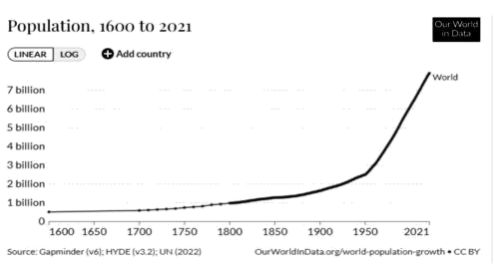
The world’s population – the number of people on the planet – has grown rapidly over the last 200 years. In 1805, for the first time ever, the Earth had a billion people on it. It took over 100 years for that number to double to two billion. In less than 50 years, it had doubled again to four billion. Now, again in less than 50 years, the number has doubled once more to eight billion.
How fast local populations are growing depends a lot on where you are in the world. Typically, as countries become richer, their population growth slows. In some countries, like Japan, the number of people is actually shrinking. The greatest population growth these days is found in Asia and Africa.
Currently, China, with a population of 1.4 billion, is the country with the most people. That’s expected to change in the next year, when experts say India will pass China as the country with the world’s largest population. Other countries where rapid growth is expected through 2050 are the Democratic Republic of the Congo, Egypt, Ethiopia, Nigeria, Pakistan, the Philippines, and Tanzania.
1. When did the world’s population reach 7 billion?| A.In 2022. | B.In 2011. | C.In 1905. | D.In 1805. |
| A.Japan’s population is increasing sharply. |
| B.Pakistan’s population keeps dropping slowly. |
| C.A country’s population completely relies on its richness. |
| D.The world’s population is growing more rapidly since 1950. |
| A.China. | B.Nigeria. | C.India. | D.Egypt. |
2 . The world’s population reached five billion on the day I was born. That was in Indonesia back in 1987, and my parents was shocked that there were so many people on the planet.
The human population has never been bigger, but in some ways the planet seems to begetting unbelievably smaller. In the past, travellers from Europe to Indonesia spent months at sea. Now you just have to sit on a plane for a few hours. When you arrived in another country a hundred years ago, you saw unfamiliar styles of clothing and buildings and discovered a completely different culture. In many places today, clothing and new buildings are very similar, and people enjoy the same things.
Even the languages that we use are becoming more global. There are around seven thousand languages in use today.
| A.But the number is decreasing fast. |
| B.Although we are on different continents, we are starting to live the same lives. |
| C.The planet might be a lot more peaceful if that were the case. |
| D.However, since then the population has continued to increase at an alarming rate. |
| E.A number as big as seven billion is hard to imagine. |
| F.With only one language left, there will be no culture difference in the world. |
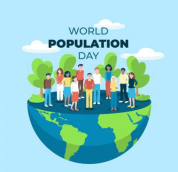
World Population Day was founded by the United Nations, and this holiday is
The idea of World Population Day started in the late 1960s,
In 1989, the world population quickly increased to five billion. During this same year, the United Nations founded World Population Day. Both events
World Population Day is celebrated in many ways‒‒much of this depends on the region. For participants who live in countries where gender
Every July 11th, the United Nations also has central celebrations in which all nations
The global population is expected to have reached 8 billion by the end of 2022, and India is predicted to surpass (超越) China as the country
“This is an occasion to celebrate our
The world population
Countries with aging populations should take steps
5 . New York, 11 July — The global population is projected to reach 8 billion on 15 November 2022, and India is projected to surpass China as the world’s most populous country in 2023, according to World Population Prospects 2022, released on World Population Day.
“This year’s World Population Day falls during a milestone year, when we expect the birth of the Earth’s eight billionth inhabitant. This is an occasion to celebrate our diversity, recognize our common humanity, and get amazed at advancements in health that have extended lifespans and dramatically reduced maternal and child mortality rates (孕妇及儿童死亡率),” said UN Secretary-General Antonio Guterres. At the same time, it is a reminder of our shared responsibility to care for our planet and a moment to reflect on where we still fall short of our commitments to one another,” he added.
World Population Prospects 2022 states that fertility (生育能力) has fallen markedly in recent decades for many countries. Today, two-thirds of the global population lives in a country or area where lifetime fertility is below 2.1 births per woman, roughly the level required for zero growth in the long run for a population with low mortality. The populations of 61 countries or areas are projected to decrease by 1 percent or more between 2022 and 2050, due to sustained low levels of fertility and, in some cases, increasing rates of emigration.
“The relationship between population growth and sustainable development is complex and multidimensional,” said Liu Zhenmin, UN Under-Secretary-General for Economic and Social Affairs. “Rapid population growth makes removing poverty, combating hunger and malnutrition (营养不良), and increasing the coverage of health and education systems more difficult. On the contrary, achieving the Sustainable Development Goals, especially those related to health, education and gender equality, will contribute to reducing fertility levels and slowing global population growth.”
1. The underlined word “surpass” can be replaced by ______.| A.overtake | B.overlook | C.overcome | D.overwhelm |
| A.The concern for global problems is a shared responsibility. |
| B.The only factor that affects those 61 countries’ populations is fertility. |
| C.The fertility has been decreasing in recent decades around the world. |
| D.The annual World Population Day is a milestone for global inhabitants. |
| A.Critical and direct. | B.Difficult and apparent. |
| C.Urgent and ambiguous. | D.Significant and complicated. |
| A.The sharp decline of fertility. |
| B.The current world population situation. |
| C.The ways to achieve sustainable development goals. |
| D.The celebration of the birth of the Earth’s eight billionth inhabitant. |
6 . On November 15, the count of humans on this planet reached 8 billion. Population growth has been steady over the past few decades. But that pattern is gradually changing, as is shown in the following chart.
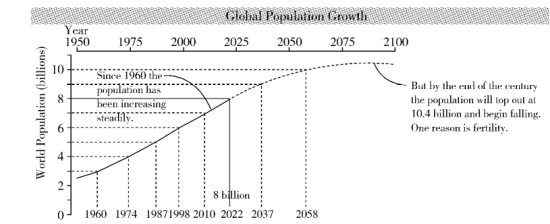
Credit: Katie Peek; Source: World Population Prospects 2022,United Nations Population Division
That slowdown is partly the result of a shift toward fewer offspring. High-income nations currently have the lowest birth rates, and the opposite is true: nations with the highest birth rates tend to have the lowest incomes. The gap has continued to widen between wealthy nations and poorer ones. But longer term, it is moving toward convergence(趋同).
Many factors contribute to the changes of the world’s population, such as migration, death rate, longevity and others. Focusing on fertility(生育率), however, helpfully clarifies why the total number of humans on Earth seems set to fall. Fertility refers to the average total number of live births per female individual in a region or country. The U.S.’s current fertility rate, for example, is about 1.7; China’s is 1.2. A fertility of 2.1 is considered the replacement rate—that is, the required number of offspring, on average, for a population to hold steady. Today birth rates in the wealthiest countries have dropped below the replacement rate, the rest likely following suit over the coming decades.
Humanity’s future clearly depends on many things besides fertility. For example, people in wealthier nations may produce fewer children, but those offspring tend to consume more resources—so rich countries can still have outsize planetary impacts despite their decreasing populations. Organizations such as the United Nations Department of Economic and Social Affairs are working toward policy-based solutions for how all of us can have healthy, satisfying and sustainable lives on Earth. A clear-eyed understanding of population changes is critical for reaching that bright future.
1. Which time period may witness the slowest global population growth?| A.1960~1974. | B.2037~2058. | C.1987~1998. | D.2022~2037. |
| A.The definition of fertility rate. | B.The cause of the low fertility rate. |
| C.The fertility rates in different countries. | D.The impact of fertility on world population. |
| A.The richer the nations are, the higher the fertility will be. |
| B.The smaller the population is, the more resources are used. |
| C.Achieving human’s sustainable future is a challenging task. |
| D.Understanding population shifts can tackle the fertility issue. |
| A.A blog entry. | B.A book review. | C.A theme speech. | D.A research report. |
7 . Population:Is 8 billion people too many?
The world’s population has reached 8 billion people.
For now, we can both acknowledge the downsides of the 8 billionth human and believe this is an occasion worth celebrating.
| A.We’ve reached this milestone |
| B.Actually, some population alarmism is appropriate |
| C.The end of population expansion is now foreseeable |
| D.The truth is that the population in developed nations has remained stable |
| E.With any luck, the massive challenge of global aging will spur innovation |
| F.The increasing global population will put more pressure on resources and produce far more emissions |
| G.In contrast, various experts have been put forward “nightmare consequences” about overpopulation since 1960s |
There’s one thing
A situation
This growing and dependent population means that there is an increased demand for health and social care. Governments will struggle to provide satisfactory pensions (养老金), which
Attitudes to an ageing population vary around the world. The Pew Research Center survey found that 87% of Japanese people were most concerned about it, while only 26% of people from the USA were. Here, immigration is helping in order
9 . For almost all of human history, the Earth's population has tended to be younger. But since the last World Population Day on July 11, a major shift occurred: There are now more people aged 65 and older than there are under age five.
World Population Day was established by the United Nations Development Program in 1989 to bring attention to population issues. Having more people on the planet is not the only concern, though, since a population's age structure matters too.
Increased lifetime is a remarkable human success story, but having more elderly people also creates a number of socioeconomic concerns. The global population will continue to age as these two groups grow in opposite directions. By 2100, the percentage of the population aged 65 and older will rise to nearly 25 percent — about five times that of children under five.
“Most developed countries have been aging for a century, giving them time to prepare for the changes. But developing countries will become old before they become rich,” says researcher Toshiko Kaneda. Many countries in Latin America and Asia are aging much faster and have less time and resources to prepare health-care systems.
What are the consequences of an older global population? Supporting elderly people is more expensive than caring for young ones. Pressing issues arise like how to provide long-term care, and maintain a labor force. In developed regions like Europe, where 10 percent of the population over age 50 is childless, elderly care is a major worry.
“Not a single country has been able to change declining trends in fertility (生育) despite government requests for people to reproduce as has been done across Europe and in Japan,” Kaneda says. “The aging trend is continuous. ”
But declining fertility rates can have positive effects too, says Kaneda. When fertility rates decline but the population hasn't aged yet, governments can spend more on secondary and higher education, and benefit the economy. Both Thailand and South Korea have seized the opportunity during this ideal period.
1. What do we know about the global population?| A.It tended to be younger until now. |
| B.People are living longer and having fewer kids. |
| C.Age structure matters more than population size. |
| D.Developed countries are facing tougher challenges. |
A.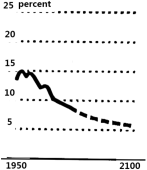 | B.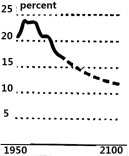 |
C. | D. |
| A.Critical. | B.Objective. | C.Optimistic. | D.Doubtful. |
| A.The declining trend in the fertility rates. |
| B.The consequences of the aging population. |
| C.The establishment of World Population Day. |
| D.The present situation of the global population. |
10 . Are you the only child in your family? If so, do you enjoy it or do you want more siblings(兄弟姐妹)?
On May 31, a key meeting of the Communist Party of China unveiled a policy that would allow all couples to have up to three children.
The move is expected to maximize the population's role in driving economic and social growth, since this is a critical time for China to transform the world's most populous country into a powerhouse(强国)with a quality workforce, according to the National Health Commission.
The three-child policy is also expected to prevent the decline in the nation's birthrate and address the challenge of a rapidly aging population, China Daily reported.
China's annual number of newborns has fallen for four years in a row. The country's total birthrate—the average number of children born to each woman—stood at 1.3 in 2020. The number is below the rate of 2.1 that would maintain a stable population, according to the National Bureau of Statistics.
The declining birthrate has also brought a sharp increase in the proportion of the population aged 60 or above, rising from 10.3 percent to 18.7 percent in the past decade. An increasingly elderly population will increase the cost of labor and the pressure on the social security net. It also means there will be a lack of young labor force. Therefore, it's not good for economic growth, according to Chen Youhua, a professor at Nanjing University.
In fact, the new birth policy is a step to further relax the family planning policy. The one-child policy was introduced in the 1970s and aimed to control the fast-growing population. Then in 2013, China allowed couples to have a second child if either parent was an only child, and in 2016, all couples were allowed to have two children.
However, not all people have shown their support for this latest policy. Many couples complained about the rising costs of raising a child. A netizen named Qinfeng commented, "High cost of education and both the physical and mental exhaustion stopped me from having more than one child." Also, many women are reluctant(不情愿的)to give birth because that could mean sacrificing their career prospects, according to Mu Guangzong, a professor at Peking University.
In that case, Mu noted that it is better to implement supporting measures with the three-child policy, such as more preferential(优惠的)policies for couples that would ease their parental burden.
1. What might NOT be the main cause for the new policy?| A.To increase the population's role. |
| B.To stop the declining birthrate. |
| C.To improve the child- care service system. |
| D.To address the challenge of the aging population. |
| A.China's annual number of newborns has fallen for decades. |
| B.The government will protect the legal rights of women in employment. |
| C.Measures will be taken to improve the high-quality education. |
| D.The new policy allows couples to have up to three children. |
| A.To carry out. | B.To get along with. |
| C.To make use of. | D.To have a command of. |
| A.To show his love of children healthcare. |
| B.To introduce the new family size policy. |
| C.To share his concerns about birthrate. |
| D.To emphasize the physical and mental exhaustion. |



